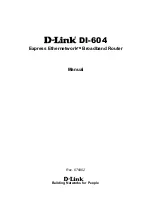
WG103 ProSafe 802.11g Wireless Access Point Reference Manual
3-8
Wireless Security
v1.0, February 2009
•
Data Encryption
. Use the information in the following table to configure the data
encryption. Note that the types of data encryption that are available depend on the
selection of the network authentication type.
•
Wireless Client Security Separation
.
Wireless client security separation must be enabled
to block unicast, multicast, and broadcast traffic between the clients of the same virtual
access point (VAP). From the pull-down menu, select one of the following options:
–
Disable
. Allows unicast, multicast, and broadcast traffic between all wireless stations.
–
Enable
. Blocks unicast, multicast, and broadcast traffic between all wireless stations.
WPA2-PSK
WPA2 is a later version of WPA. Select this option only if all clients support
WPA2. If selected, you must use AES encryption, and enter the WPA
passphrase (Network key). See
“Configuring WPA” on page 3-12
.
WPA-PSK &
WPA2-PSK
This option allows clients to use either WPA (with TKIP) or WPA2 (with
AES). If selected, encryption must be TKIP + AES. The WPA passphrase
(Network key) must also be entered. See
“Configuring WPA” on page 3-12
.
Table 3-2. Data Encryption Settings
Field
Description
None
No encryption is used.
64 bits WEP
Standard WEP encryption, using 40/64 bit encryption. See
“Configuring
WEP” on page 3-10
.
128 bits WEP
Standard WEP encryption, using 104/128 bit encryption. See
“Configuring
WEP” on page 3-10
.
152 bits WEP
Proprietary mode that will work only with other wireless devices that
support this mode. See
“Configuring WEP” on page 3-10
.
TKIP
This is the standard encryption method used with WPA. See
“Configuring
WPA” on page 3-12
.
AES
This is the standard encryption method for WPA2. Some clients may
support AES with WPA, but this is not supported by this wireless access
point. See
“Configuring WPA” on page 3-12
.
TKIP + AES
This setting supports both WPA and WPA2. Broadcast packets use TKIP.
For unicast (point-to-point) transmissions, WPA clients use TKIP, and
WPA2 clients use AES. See
“Configuring WPA” on page 3-12
.
Table 3-1. Network Authentication Types (continued)
Field
Description
















































